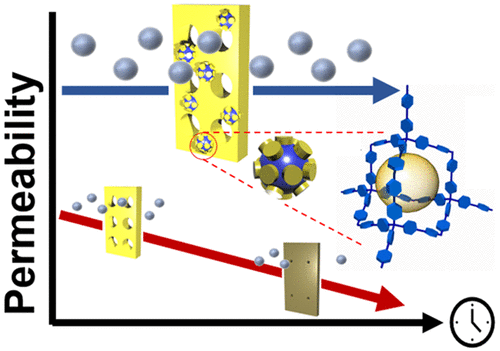当前位置:
X-MOL 学术
›
Acc. Chem. Res.
›
论文详情
Our official English website, www.x-mol.net, welcomes your
feedback! (Note: you will need to create a separate account there.)
Control of Physical Aging in Super-Glassy Polymer Mixed Matrix Membranes.
Accounts of Chemical Research ( IF 16.4 ) Pub Date : 2020-07-05 , DOI: 10.1021/acs.accounts.0c00256 Stefan J D Smith 1, 2 , Rujing Hou 2 , Kristina Konstas 1 , Ammara Akram 3 , Cher Hon Lau 1, 3 , Matthew R Hill 1, 2
Accounts of Chemical Research ( IF 16.4 ) Pub Date : 2020-07-05 , DOI: 10.1021/acs.accounts.0c00256 Stefan J D Smith 1, 2 , Rujing Hou 2 , Kristina Konstas 1 , Ammara Akram 3 , Cher Hon Lau 1, 3 , Matthew R Hill 1, 2
Affiliation

|
Since the discovery of polymers of intrinsic microporosity (PIMs) in 2004, the fast size-selective interconnected pore cavities of the polymers have caused the upper bound of membrane performance to be revised, twice. Simultaneously, porous materials have meant that mixed matrix membranes (MMMs) are now a relatively simple method of enhancing transport properties. While there are now reliable routes with mixed matrices to improve the fundamental transport properties of membrane materials, many of the other properties crucial for separation applications remain largely unaddressed. Physical aging severely affects membrane performance over time, especially for those prepared from high fractional free volume polymers. Gradual densification of the glassy polymer chains causes the connected pore channels present in these materials to constrict. Studies now suggest that aging of superglassy polymer materials is a two-step process; a rapid densification occurs within the first few days, followed by a gradual rearrangement of packed chains over longer time frames toward a theoretical equilibrium state. Although advantageous in terms of size selectivity, the considerable drop in permeation over the days and weeks after manufacture greatly impacts material applicability. While often still permeating faster than traditional membrane materials, the continuous gradual collapse of cavities in these polymers are a significant challenge in the application of high free volume polymer membranes. In 2014, we discovered that the porous aromatic framework PAF-1 not only greatly improved the membrane’s void space and speed of gas transport but also seemingly froze several glassy polymers in a low-density state, holding the polymer’s pore channels open, a process termed as Porosity Induced Side chain Adsorption (PISA).
中文翻译:

超玻璃态聚合物混合基质膜的物理老化控制。
自从2004年发现具有固有微孔性(PIM)的聚合物以来,聚合物的快速尺寸选择互连孔腔已使膜性能的上限两次被修改。同时,多孔材料意味着混合基质膜(MMM)现在是提高运输性能的相对简单的方法。虽然现在有使用混合基质的可靠方法可以改善膜材料的基本传输性能,但对于分离应用至关重要的许多其他性能在很大程度上仍未解决。随着时间的流逝,物理老化会严重影响膜的性能,尤其是对于那些由高分数自由体积聚合物制备的膜。玻璃状聚合物链的逐渐致密化导致这些材料中存在的连通孔道收缩。现在的研究表明,超玻璃态聚合物材料的老化是一个两步过程。在最初的几天内迅速致密,然后在更长的时间内逐渐重排堆积的链,达到理论平衡状态。尽管就尺寸选择性而言是有利的,但是在制造后几天和几周内渗透率的显着下降极大地影响了材料的适用性。尽管通常仍比传统的膜材料更快地渗透,但这些聚合物中空腔的连续逐渐塌陷对于高自由体积聚合物膜的应用是一个重大挑战。在2014年,
更新日期:2020-07-21
中文翻译:

超玻璃态聚合物混合基质膜的物理老化控制。
自从2004年发现具有固有微孔性(PIM)的聚合物以来,聚合物的快速尺寸选择互连孔腔已使膜性能的上限两次被修改。同时,多孔材料意味着混合基质膜(MMM)现在是提高运输性能的相对简单的方法。虽然现在有使用混合基质的可靠方法可以改善膜材料的基本传输性能,但对于分离应用至关重要的许多其他性能在很大程度上仍未解决。随着时间的流逝,物理老化会严重影响膜的性能,尤其是对于那些由高分数自由体积聚合物制备的膜。玻璃状聚合物链的逐渐致密化导致这些材料中存在的连通孔道收缩。现在的研究表明,超玻璃态聚合物材料的老化是一个两步过程。在最初的几天内迅速致密,然后在更长的时间内逐渐重排堆积的链,达到理论平衡状态。尽管就尺寸选择性而言是有利的,但是在制造后几天和几周内渗透率的显着下降极大地影响了材料的适用性。尽管通常仍比传统的膜材料更快地渗透,但这些聚合物中空腔的连续逐渐塌陷对于高自由体积聚合物膜的应用是一个重大挑战。在2014年,











































 京公网安备 11010802027423号
京公网安备 11010802027423号